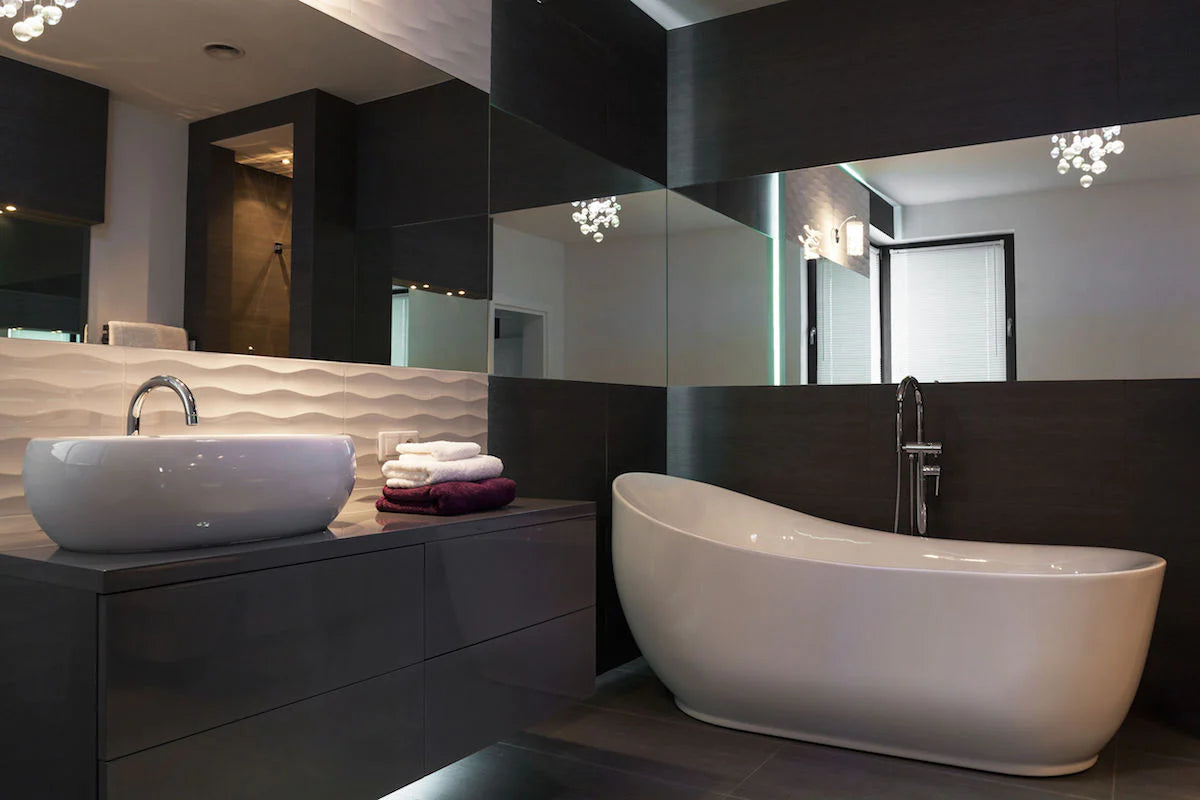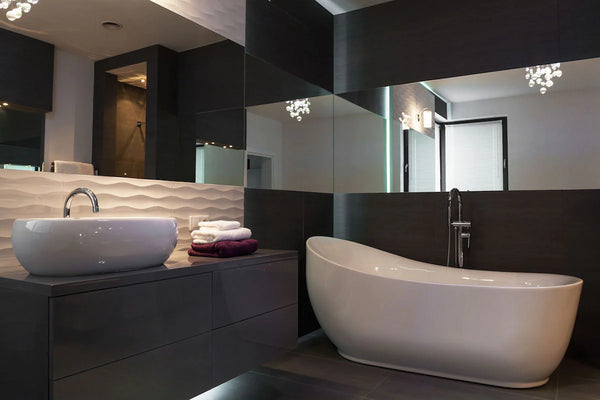Lighting, plumbing and wall fixtures are essential elements to consider when remodeling or designing a bathroom. However, choosing the right finishes and materials for these items can pose a major challenge because there are so many options.
Whether you’re seeking a complementary color scheme or a more monochromatic look, here’s how to achieve consistency across all fixtures in the bathroom.
An Introduction to Bathroom Design Consistency
To create a harmonious look in your bathroom, consistency is key. But what does design consistency actually look like? Contrary to popular belief, it isn’t just using the same colors and patterns across every element.
In fact, interior designer Jennifer Cederstam points out that contrast is important for adding drama and interest. Placing strikingly different elements next to each other emphasizes both objects and draws attention to the area. Following this principle throughout the bathroom creates balance, ensuring that the space remains aesthetically pleasing.
Creating a consistent design theme also requires the consideration of details, according to the Tasteful Space blog. Finishing touches need to be considered in order to keep a theme unified. In the bathroom, these details include lights, hardware, tapware and plumbing fixtures. Ensuring they don’t clash in color or design style allows your bathroom a harmonious look.
The bathroom should be designed with the rest of the house in mind, too. While it’s easy to get caught up on the bathroom trends of the moment, focusing too much on one single room at a time can cause the space to clash with the rest of the house, writes interior designer Kate Hatherell, founder of The Home Design School.
Instead, creating a whole home plan makes it easier to shop for the right fixtures and decor with confidence. When you know which colors and styles fit the rest of your home, you can be sure that you’re purchasing items that suit the personal brand outlined in your home. This can include consistency across tapware and fixtures in the bathroom and the kitchen.
Choosing Complementary Fixtures
Fixtures don’t always have to be a perfect match in order to work well together. If you’re more interested in mixing and matching styles, or simply want contrast between fixture pairings in the bathroom, a complementary approach may be best. Opting for a complementary design scheme can help you achieve a naturally cohesive flow, according to the team at Supply.com.
“The bathroom typically has more plumbing fixtures than any other room in the house, so it’s understandable that perfectly matching all of them within the same brand, style, and finish can be a bit of a hassle,” they explain.
Another way to approach complementary fixture pairing is to think about creating a focal point in the bathroom. Perhaps you have a standout vintage-inspired bathtub, or a sleek modern sink, for example. The lighting and plumbing fixtures can cater to this piece to increase attention to it.
The focal point can be anything, though, even a light fixture itself or a picture on the wall. “Lighting can be used as a tool to draw attention to any element in the room you want to be your focal point, such as a piece of artwork or a fireplace mantel,” writes lighting designer Sonia Roberton. Track lighting and wall sconces are great light sources for framing a bathroom fixture or decor piece and directing the eye towards it.

Achieving Bold Design Departures
If you want to make a bold design statement without sacrificing design harmony, consider how bright colors can complement and contrast against other details.
For example, bold, colorful faucets can be a playful complement in a bathroom, says Apartment Therapy’s Nancy Mitchell. Fixtures can be paired with wall colors too, adding contrast to an all-white bathroom or enhancing a colorful space. One bathroom Mitchell showcases features a bright yellow faucet in an otherwise modern bathroom comprised of muted blues and whites. In this instance, the yellow ties in with a gold lighting fixture above the sink.
Another example of bold tapware can be found in a children’s bathroom designed by Brooklyn-based GRT Architects. Here, a bright red faucet is set on a white sink in front of a white tile scheme. An asymmetrical shelf in teal complements the red, and a subtle strip of red in a slightly different hue inside the shelf, placed to the right of the sink, helps balance the bright faucet for a cohesive look.
If a bold design like this appeals to you, start by choosing three colors to focus on in the bathroom. The rule of three is a fundamental design principle that can aid in a cohesive scheme across fixtures and colors, explains Kelly Roberson at Better Homes and Gardens.
“Pick one neutral, one rich color, and one accent. To do it successfully, think about proportion and rely on a 70/20/10 distribution: Use the lightest color for 70 percent of the room's decor, the second lightest for 20 percent, and the boldest for 10 percent,” she writes.

Fixture Combination Ideas
With so many options for fixture combinations, it can be hard to narrow down the choices. One factor to think about how warm and cool tones and colors work together. Chrome works better with cooler tones, says interior decorator Diana Moore. Chrome looks better with blues, greens and grays because it has blue and silver undertones.
On the flip side, copper and brass tapware have more layers of warmth on their surfaces. This makes them better suited for taupes, reds, beiges, oranges and coral. If you already have an idea of which color you’d like in the bathroom, this can inform the fixture color or type that you should choose.
Matte black is one trending fixture finish that complements a variety of textures, colors and materials. Black fixtures can be used to add a graphic pop against white walls, says Christa Pirl at Domino. In contrast, matte finishes can be used to enrich already saturated hues such as midnight blue, eggplant purple or jade green. When pairing matte black fixtures with materials, earthy textures like wood, stone, concrete and marble are perfect.
More fixture combination ideas come from designer Sarah Gibson. She prefers to mix metals for a more curated look that prevents the bathroom from feeling basic and boring. “In our guest bath, we’ll be using antique brass faucets, towel hooks, and shower trim, but you’ll also see plenty of polished nickel paired alongside the brass. The wall mirrors have nickel frames, the vanity hardware is also polished nickel, as well as the light fixtures,” she writes.
Another way to hone in your fixture pairings is to think about the theme or era of the bathroom. “Brass tapware works great in industrial, steampunk, outdoor, mid-century and old English themed bathrooms,” explains the team at ATS Tiles and Bathrooms as an example.
Rose gold tapware looks striking with black and beige finishes and materials, and gold finish tapware compliments light marble or black, they add. Trying to use two different shades of gold in the same color scheme, however, is a risky design move that should mostly be avoided. Deciding on a material, color or finish to anchor and inform the overall bathroom design will ensure that the rest of the elements fall into place.
Images by: Katarzyna Białasiewicz/©123RF.com, Katarzyna Białasiewicz/©123RF.com, iriana88w/©123RF.com







